Back in 1980, independent watchmaker Svend Andersen founded his own workshop in Geneva’s city center on the picturesque banks of the Rhône river. It was fortuitous timing because, while Switzerland was then in the throes of the quartz crisis, it would soon be entering a renaissance of mechanical watchmaking.
Unbeknownst to him at that time, Andersen was about to play a significant part in that new era of revitalized interest in mechanical watchmaking when in 1985 he co-founded with Vincent Calabrese the A.H.C.I., a group of independent creators building on the premise of strength in numbers.
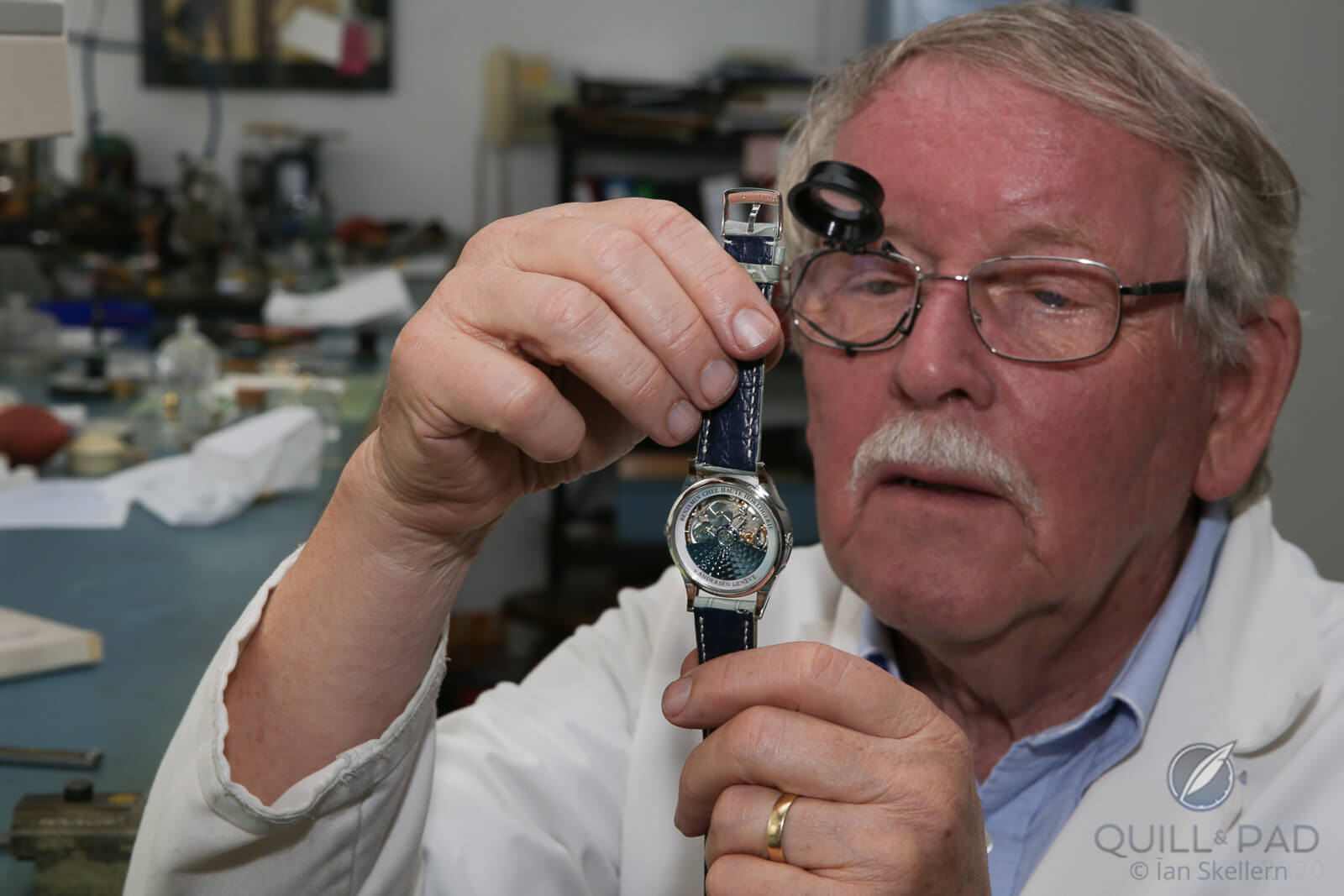
Svend Andersen in his Geneva workshop in June 2021
The A.H.C.I. (Academie Horlogère des Créateurs Indépendents/Horological Academy of Independent Creators) is a loose grouping of currently 31 talented independent watchmakers and five candidates hailing from 14 countries.
As Andersen’s workshop and beloved grouping of watchmakers progressed through time, finding themselves at the center of an uptick in global horological creativity, the watch industry became ever more fast-paced and more and more industrialized. And demand for rare luxury became tangible, fueling the independent movement.
Independent creators provided – and continue to provide – inspiration and creative exchange between themselves and collectors and enthusiasts.
True luxury is rare, but in the ability to make unique and personalized timepieces according to the customer’s desires, Andersen’s workshop has excelled, now able to boast having made more than 100 pièces uniques among a grand total of approximately 1,500 timepieces spanning 40 years of a truly inventive career.
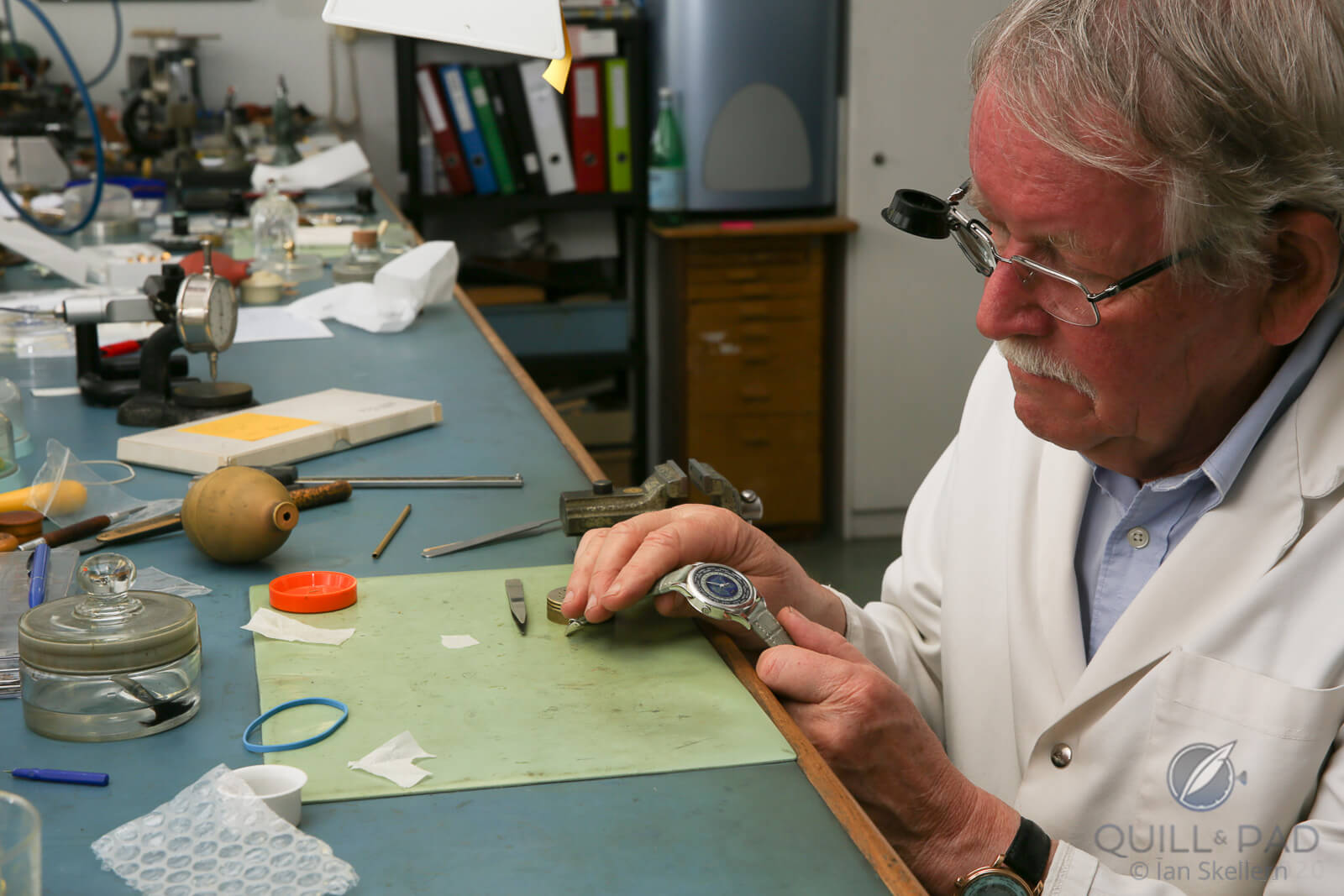
Svend Andersen working at his bench in June 2021
Today Andersen is 79 years old and still active in the workshop today. His age, though, might explain why late in 2015 the news came through that Andersen, who had moved to Geneva in 1963 from his native Denmark, had sold his company.
“Yes, but it’s more a ‘transition’ than a sale,” Andersen laughed back in January 2016 as we enjoyed a toast to independent watchmakers together. “For me horology is not only a profession, it’s a passion. And it’s life.”
And right on cue, the new owner sitting next to him raised his glass and confirmed what his business partner was saying. “Svend’s not really retiring,” said Pierre-Alexandre Aeschlimann, president of Andersen Genève SA since March 2015.
While Aeschlimann’s obvious enthusiasm for both horology and Andersen’s creations were immediately obvious, today’s story is about 40 years of a workshop and a snapshot of 26 years of a watch model that began, as most stories involving Andersen do, with a unique creation for a client.
A client and the origins of the Cartier Jour et Nuit
Our own Ian Skellern pointed out in his 2010 book The Hands of Time, which was published on the occasion of the twenty-fifth anniversary of the A.H.C.I., that few of Andersen’s watches are very well-known because, as Andersen told him at the time, “90 percent of my inspiration comes from people asking if something is possible. I never say no; I will always think about it.”
Andersen, whose nickname was “watchmaker of the impossible,” was always known as being very inventive and was often asked by other brands to develop complications or watches for them that did not bear the Danish watchmaker’s own name.
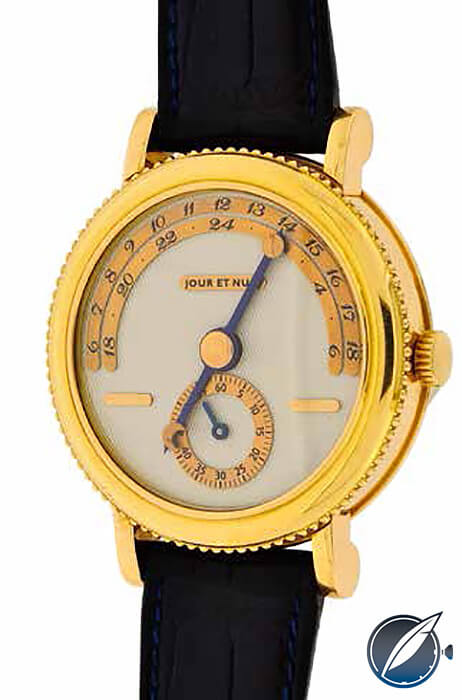
Svend Andersen’s unique piece Jour et Nuit for Walter Haselberger from 1995 (photo courtesy Ineichen)
Such was the case with the Cartier Pasha Jour et Nuit, which the famous brand commissioned after seeing a unique piece that Andersen had created for a client.
The unique piece made for collector Walter Haselberger, which Ineichen Auctions in a November 2014 catalogue described as the “prototype for the Cartier Pasha Jour et Nuit (master model),” appeared in 1995 housed in a yellow gold case lovingly made by Jean-Pierre Hagmann with what appears to be little granules around the bezel. Its unique movement, based on a vintage Victorin Piguet pocket watch minute repeater movement, included a jumping hour with day/night display that became one of Andersen’s signature technical elements.
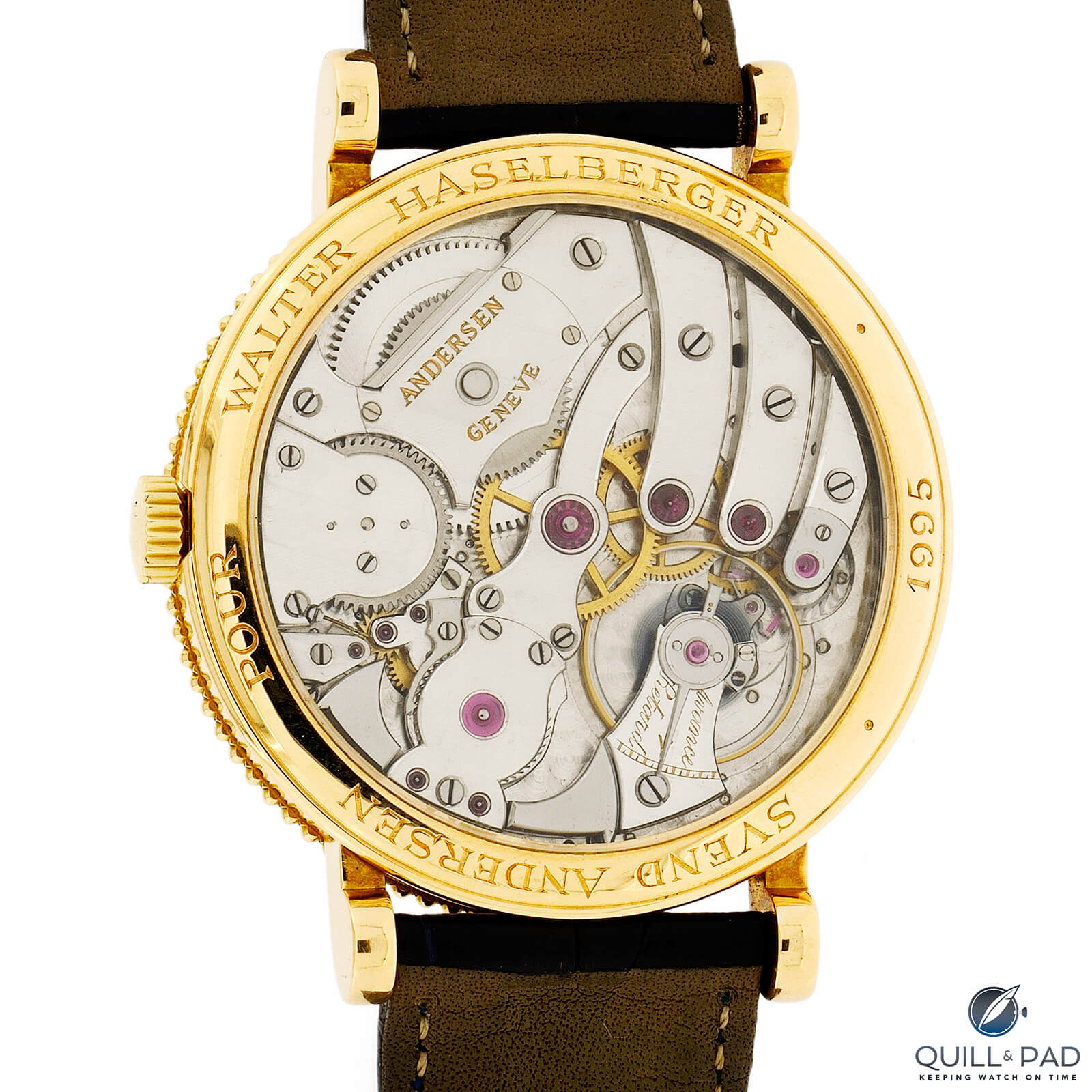
Back of Svend Andersen’s unique piece Jour et Nuit for Walter Haselberger from 1995; note the modified Victorin Piguet repeater movement (photo courtesy Ineichen)
Hagmann, a celebrated case maker who sends collectors searching for his “JHP” hallmark on cases from Geneva that he created for prestigious clients over the years, officially retired in 2017. After selling his workshop and equipment to Vacheron Constantin, Hagmann came out of retirement in 2020 to work with Rexhep Rexhepi/Akrivia.
The “prototype” for the Cartier Pasha Jour et Nuit’s handcrafted double-sided single hand of uneven lengths, displays day or night using the moon (night) and the sun (day) and a double row of hour numerals ranging from 1 to 24. The hand jumps from one marker to the next; it does not glide.
Finally, the little blued hand in the subdial at 6 o’clock shows the minutes. The silver dial is hand-guilloche.
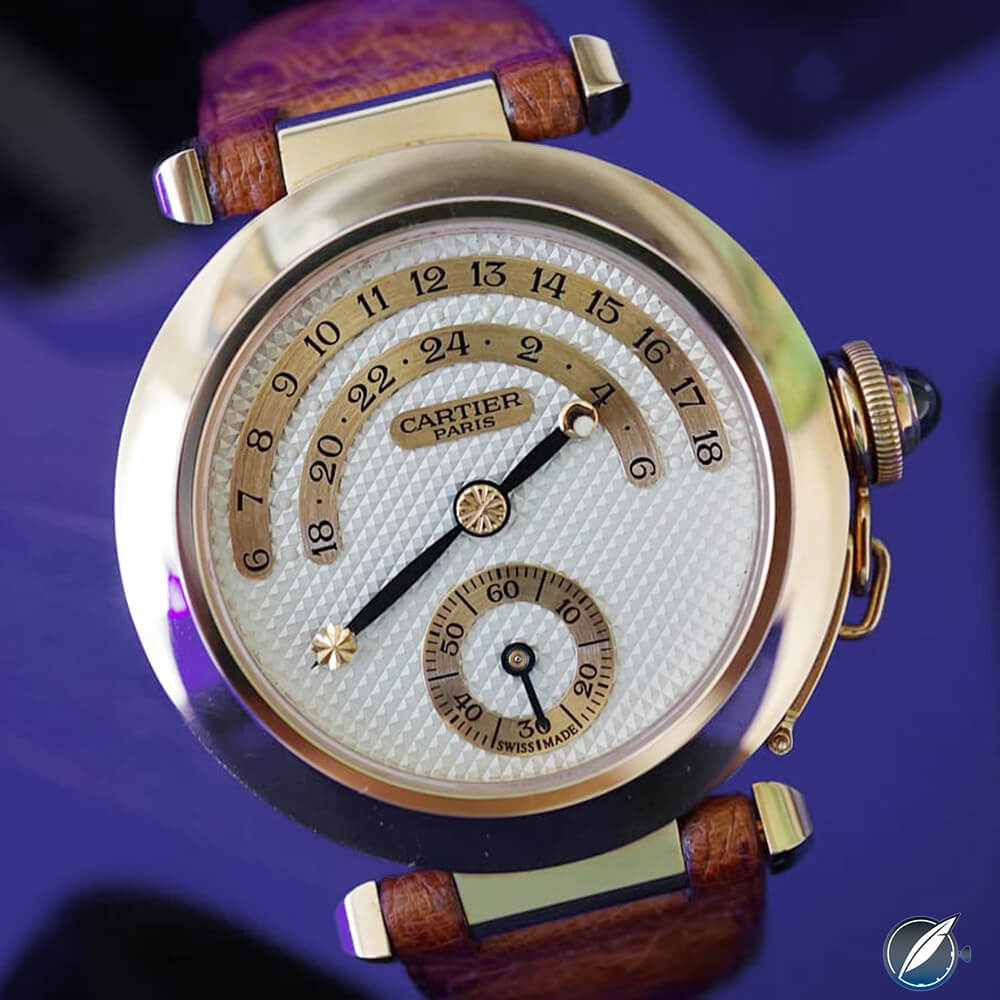
Cartier Pasha Jour et Nuit from 1998 (photo courtesy George Cramer)
The Cartier Pasha Jour et Nuit wristwatch had a 38 mm gold case and launched in 1998 in a limited edition of 125 watches, which was a considerable number for a Cartier limited run at the time as it was (and perhaps still mostly is) a brand known for its dress watches.
The Cartier timepieces were based on Frédéric Piguet Caliber 15 and modified by Svend Andersen. George Cramer, author of Cartier, The Gentleman’s Files, explained to me that Cartier allowed Andersen to release his own versions of the watch.
Svend Andersen “Deuxième” Jour et Nuit
Two other watches, also marked “prototypes” by Ineichen in the same auction catalog, featured gold cases by Hagmann and the 18-karat blue gold dials by Geneva-based goldsmith Ludwig Muller that would become another of Andersen’s characteristic elements.
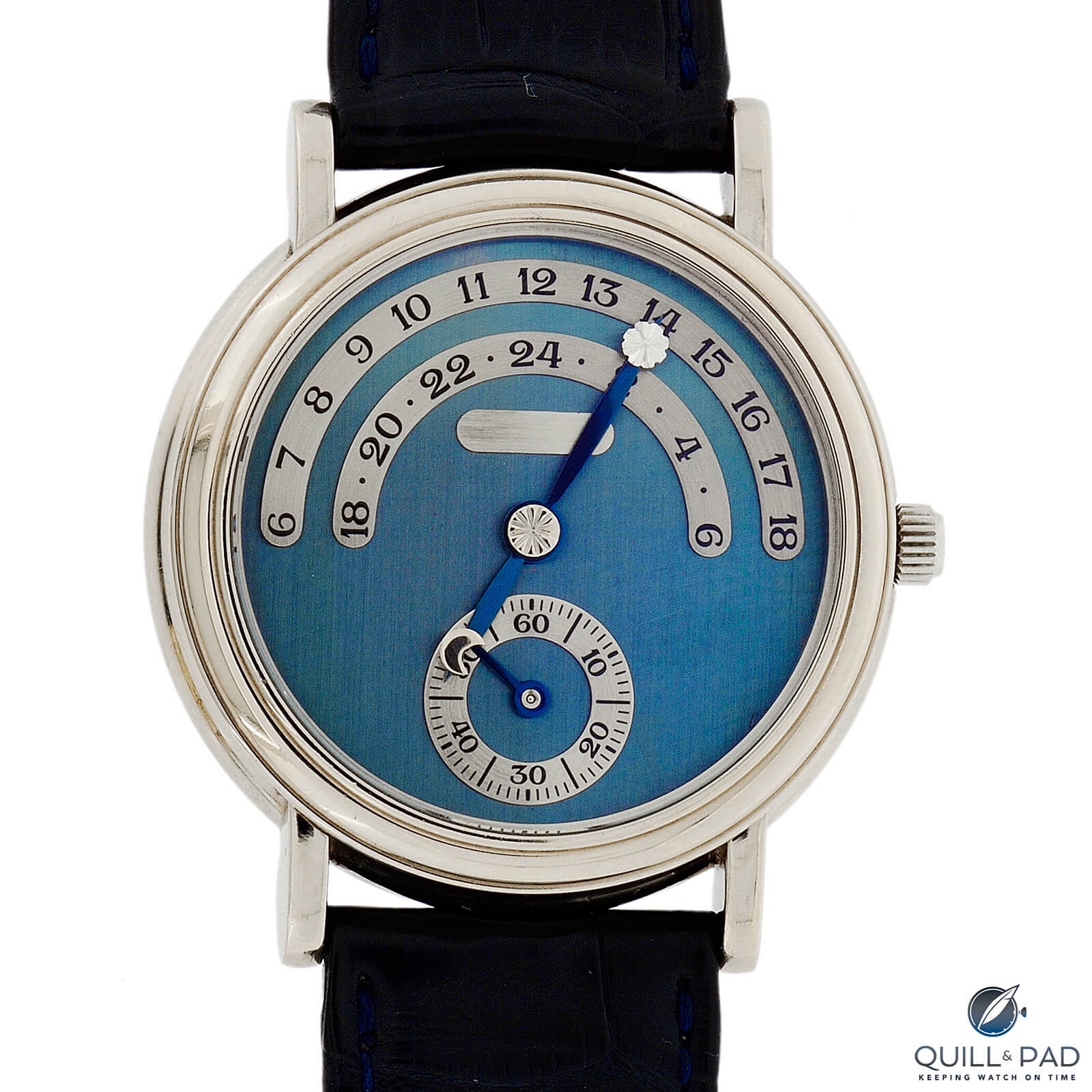
Svend Andersen Jour et Nuit blue gold prototype (photo courtesy Ineichen)
One of these (pictured below) was called the “Deuxième Jour et Nuit” – the “second Night and Day.” It was never realized in series.
These two were made around 2000 in white gold cases by Hagmann according to drawings by Haselberger. The blue dials feature white gold appliqués.
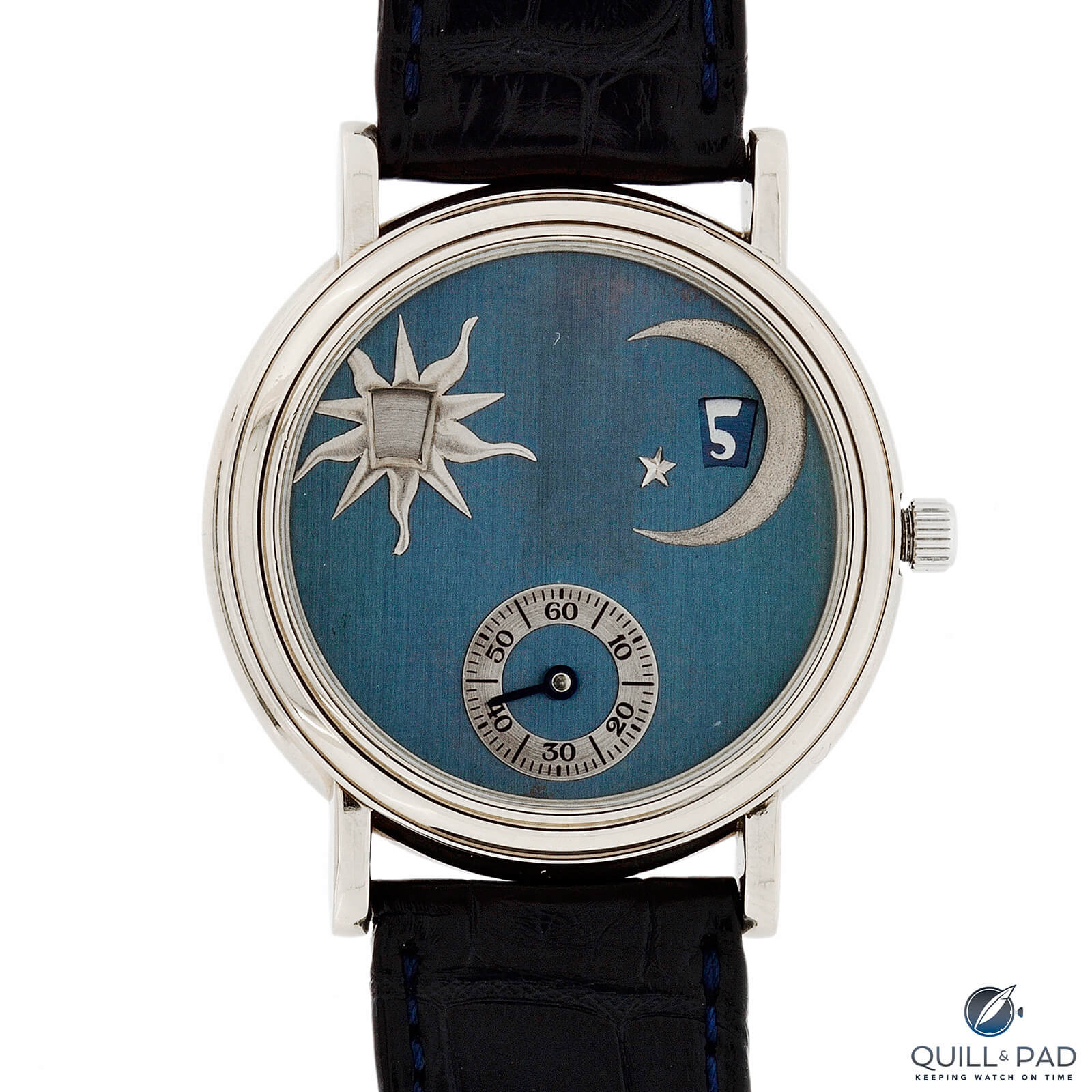
Svend Andersen “Deuxième” Jour et Nuit with blue gold dial (photo courtesy Ineichen)
The movements of these two pieces were based on Frédéric Piguet Caliber 1195, modified by Svend Andersen, and patented. Cartier bought the patent for the model featuring the double jump hour windows at 11 and 2 o’clock shown above and even patented one further element, but never put this watch into production. It has thus far remained unique as the “Deuxième Jour et Nuit.”
Andersen Genève Grand Jour et Nuit first edition, 2000
It comes as no surprise then that even though it was introduced 21 years ago at Baselworld 2000, Andersen’s own Grand Jour et Nuit is perhaps not his most well-known watch as it was somewhat overshadowed by the Cartier model released two years previously.
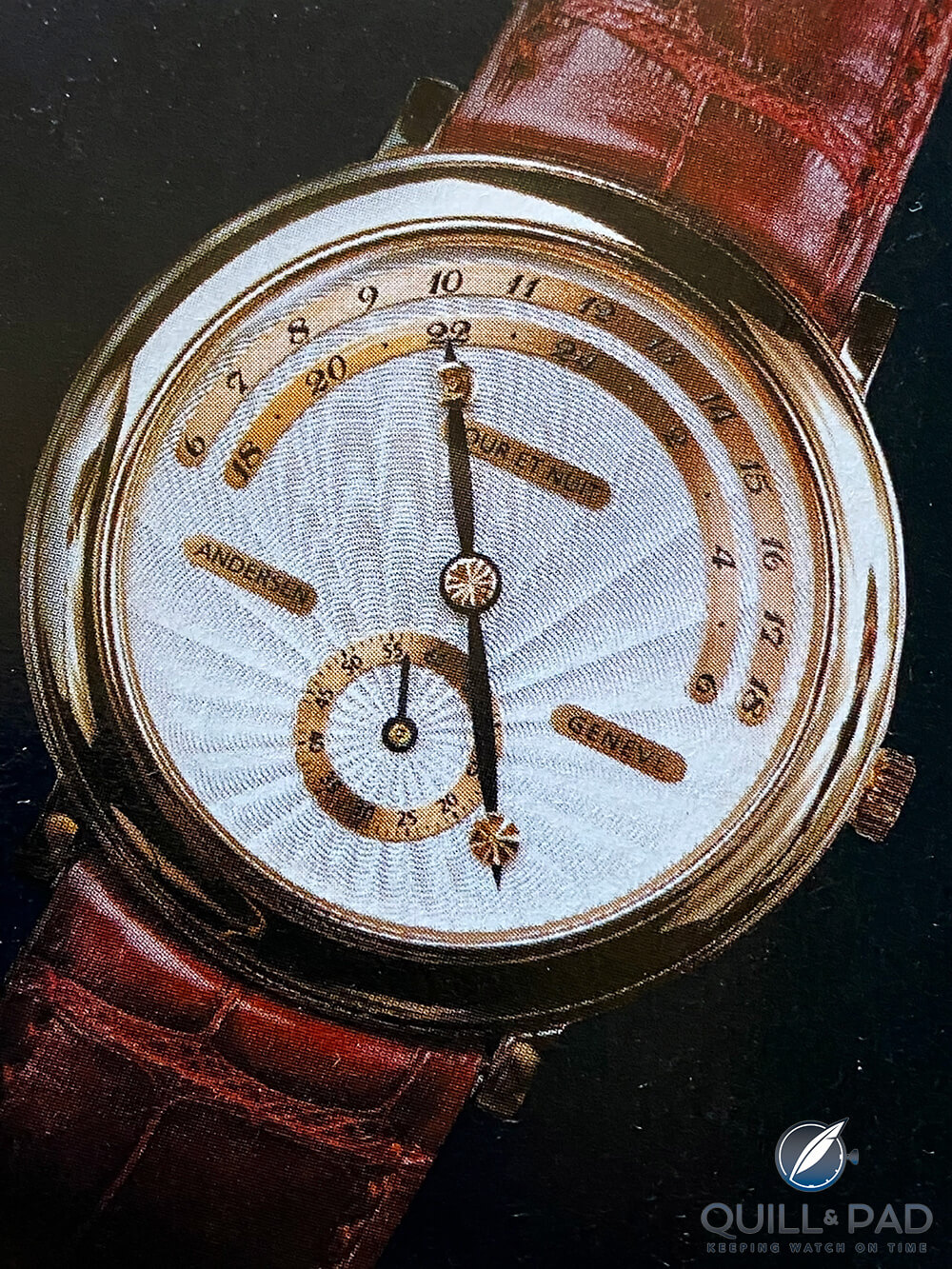
Svend Andersen Grand Jour et Nuit first edition, 2000
Andersen called his 2000 version “Grand” because he “grew” the case to a full 42 mm, which was considered rather large 21 years ago, but the size has ensured that the watch has continued to look contemporary all this time.
Issued only in a 20-piece limited edition, the 20 cases were made by Hagmann and Geneva-based case maker Jean-Pierre Scherrer. This edition came in white or red gold, and the hand-guilloche dial sported applied dial elements dominated by the double arc of the 24-hour markings.
Andersen Genève Grand Jour et Nuit second edition
Many years later, Andersen Genève was able to purchase the last 50 remaining Frédéric Piguet 15-ligne movements, which had begun production in the 1960s, before the maker – now having been acquired by Swatch Group – discontinued the large wristwatch movement that Andersen had been using in the Grande Jour et Nuit.
The Swatch Group (then called SMH) had acquired Frédéric Piguet along with its sister brand Blancpain in 1992. As an aside, today movements are no longer manufactured under the Piguet name but rather “Blancpain manufacture.”
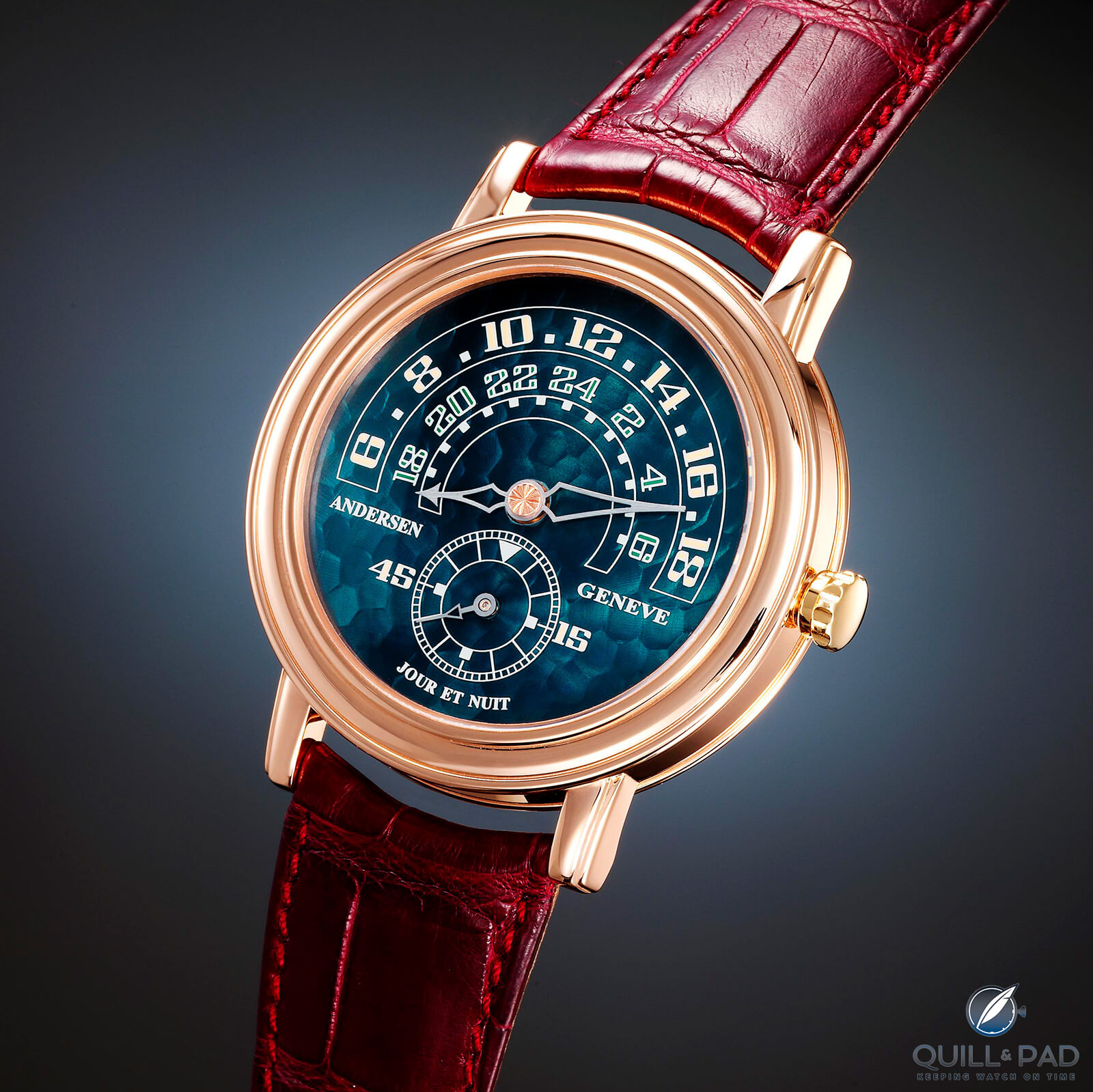
Svend Andersen Grand Jour et Nuit second edition with blue gold dial
And this is how the second edition of the Grand Jour et Nuit came about in a limited edition of 30 pieces in red gold and 20 pieces in white gold with cases made by Scherrer.
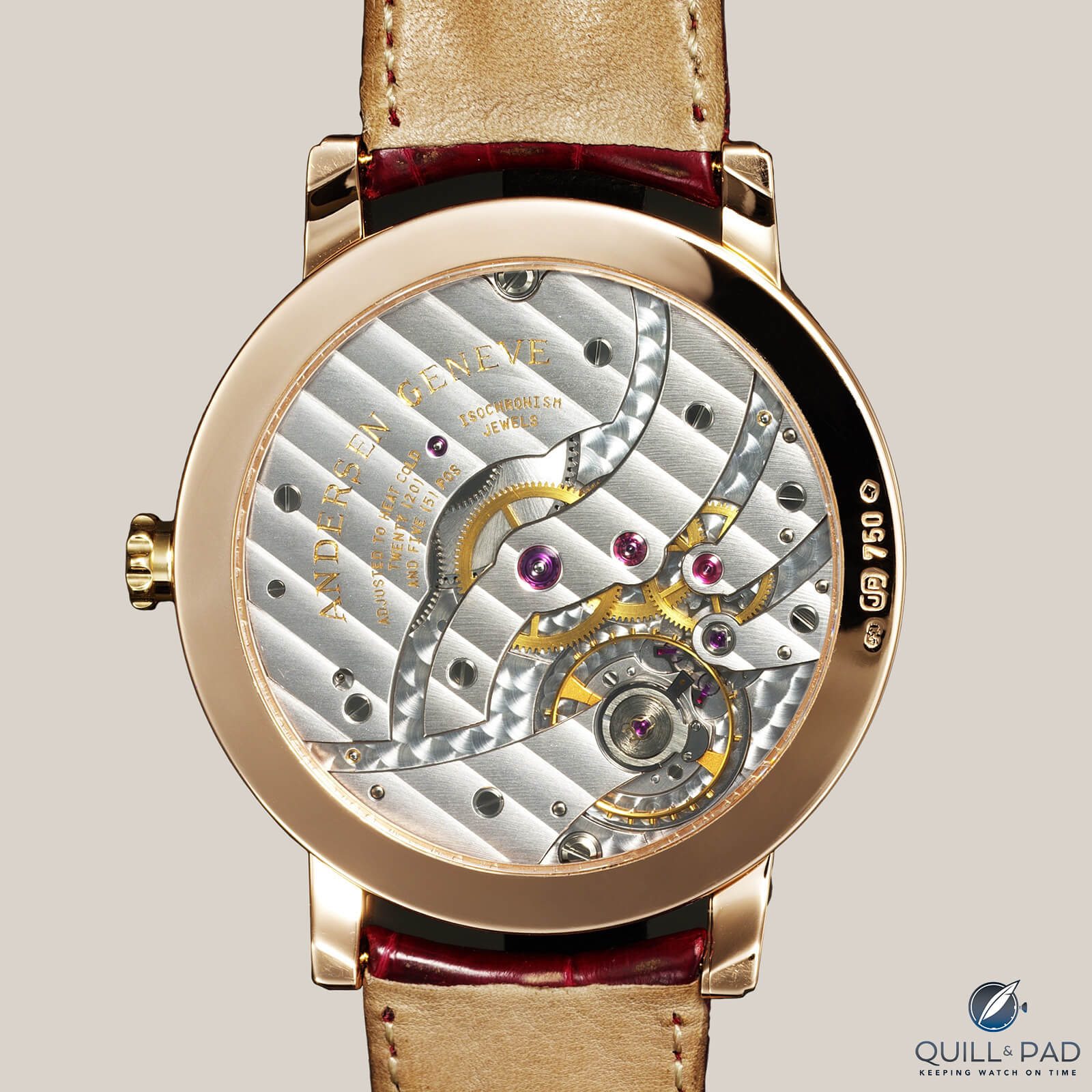
Back of the Svend Andersen Grand Jour et Nuit second edition
The classically constructed manual-winding movement is ultra-flat and modified by Andersen Genève to accommodate the ingenious jumping 24-hour mechanism. Its aesthetic simplicity is completed with beautiful hand-finishing including Geneva waves, perlage, and anglage, all of which are visible through the sapphire crystal case back.
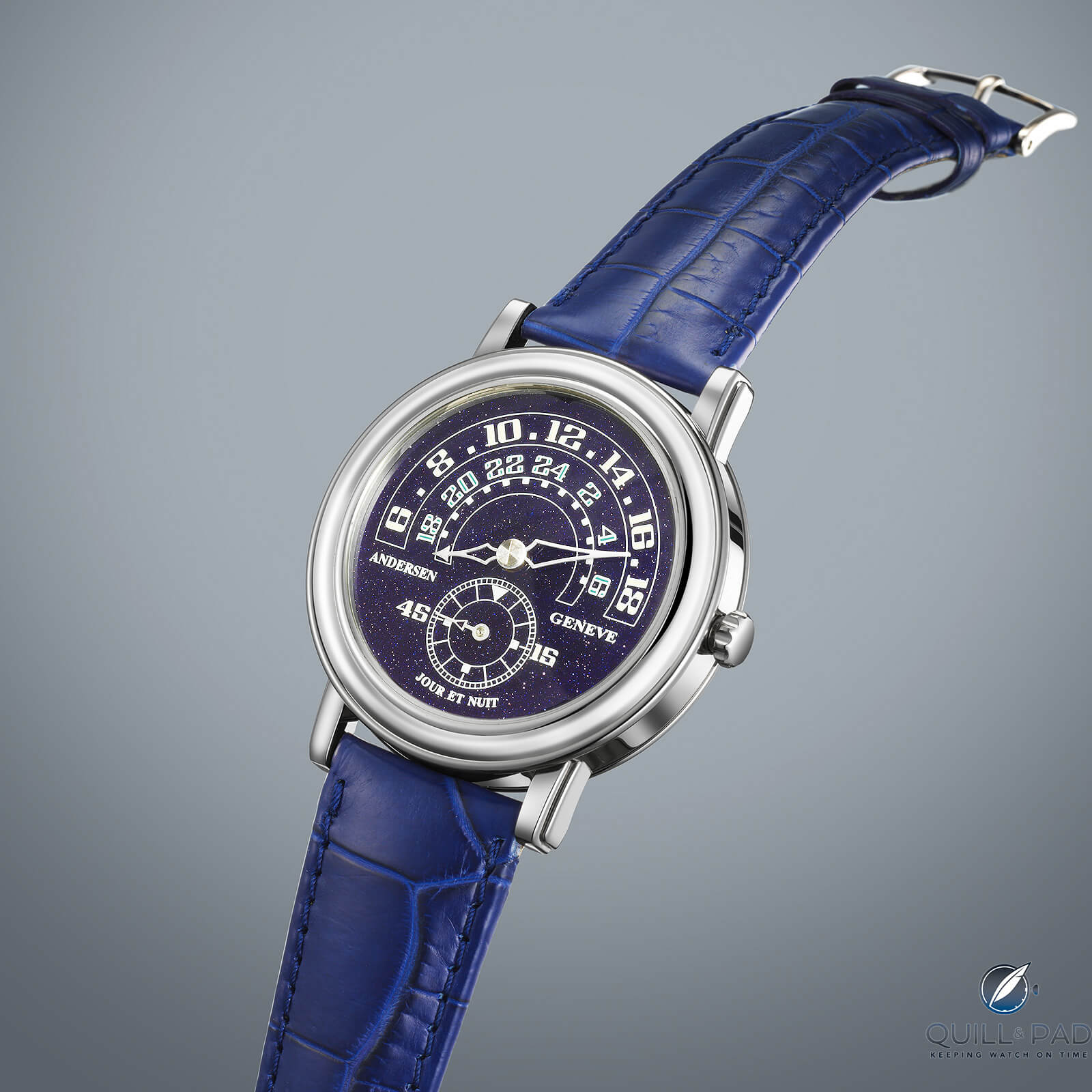
Svend Andersen Grand Jour et Nuit second edition with aventurine dial
Andersen Genève created a large variety of dials this time around, including unique pieces commissioned by clients, which have included materials like hand-guilloché, Andersen’s famous blue gold, and even stones like jade, white marble, and grossularite. Aventurine of course is also among the unusual and beautiful dial materials.
The limited-edition pieces are numbered 01-30/30 and 01-20/20.
2020: Andersen Genève Jumping Hours 40th Anniversary in 5N red gold
The Andersen Genève Jumping Hours 40th Anniversary is the most recent evolution of Svend Andersen’s jumping hours/day and night timepieces that began with the unique watch for Haselberger in 1995. And in some ways, now it comes full circle – with a commission, of course.
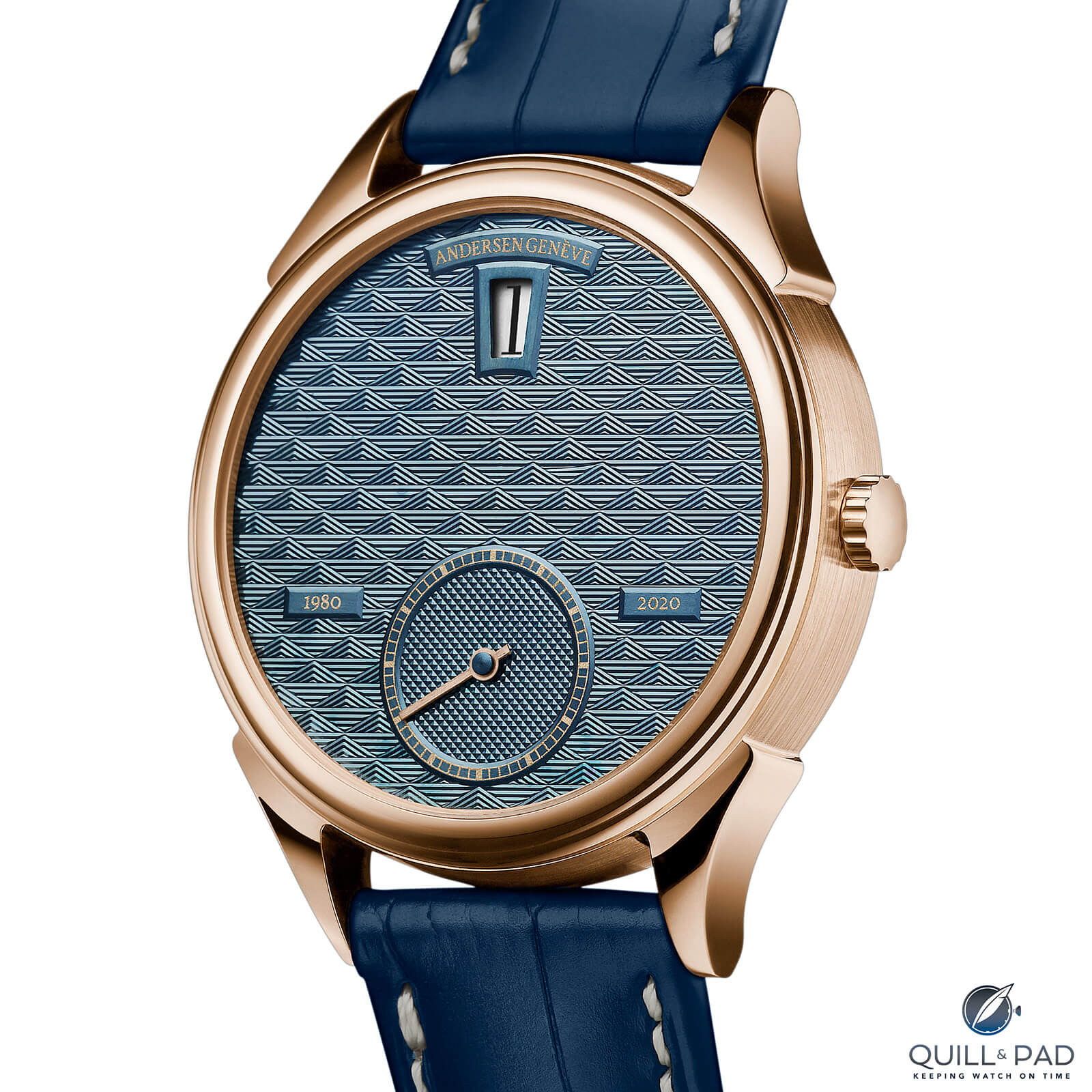
Andersen Genève Jumping Hours 40th Anniversary
Thanks to a unique piece commissioned by Adrian Alred of Convopiece, Andersen Genève crafted a simplified version of the Jour et Nuit that more closely resembles the original “prototype” of 1995 that was never put into series. Inspired by late-eighteenth century jump hour pocket watches, this timepiece no longer featured the day-and-night functionality, but rather a more conventional jump hour window (if that can be called at all conventional).
The unique piece’s dial blended simplicity, balance, and contrasting textures, though it did not feature guilloche but rather a cleanly hand-brushed surface. Andersen Genève added the guilloche dial that had been a part of the independent creator’s 40-year legacy of the Jour et Nuit for its Jumping Hours 40th Anniversary series.
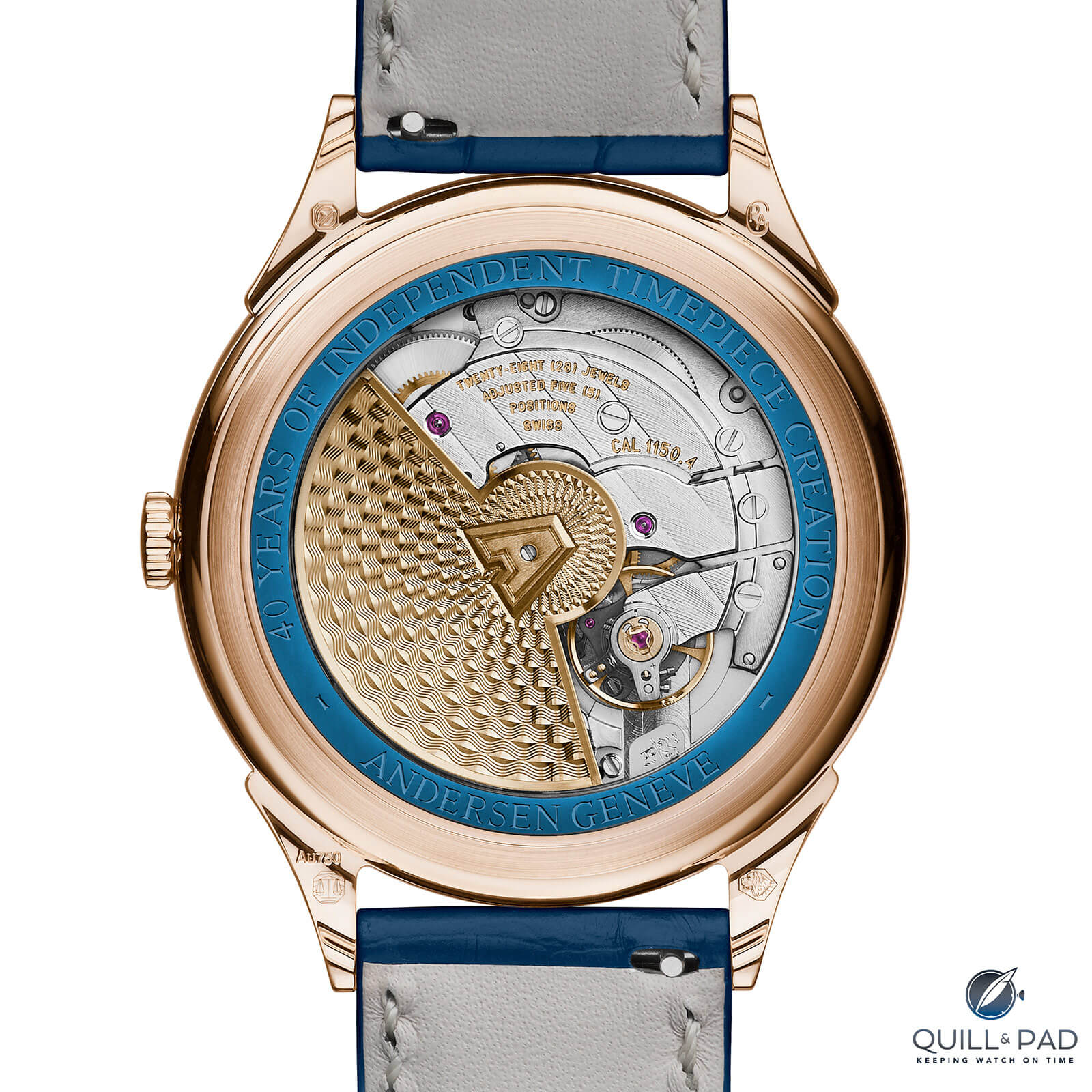
Back of the Andersen Genève Jumping Hours 40th Anniversary
As well as the guilloche, the Jumping Hours 40th Anniversary revisits other characteristic highlights of Svend Andersen’s watches: the blue gold dial, the minute indicator subdial that has followed the Jour et Nuit for all these years, and the jumping hour display.
The handcrafted guilloche is impressive; the complexity of this highly three-dimensional guilloche work graces the dial as well as the movement’s 18-karat yellow gold winding rotor, which is decorated with grain d’orge-style guilloche. And, as always, these delightful elements were made with the help of outstanding Geneva-based artisans who are masters in their respective fields.
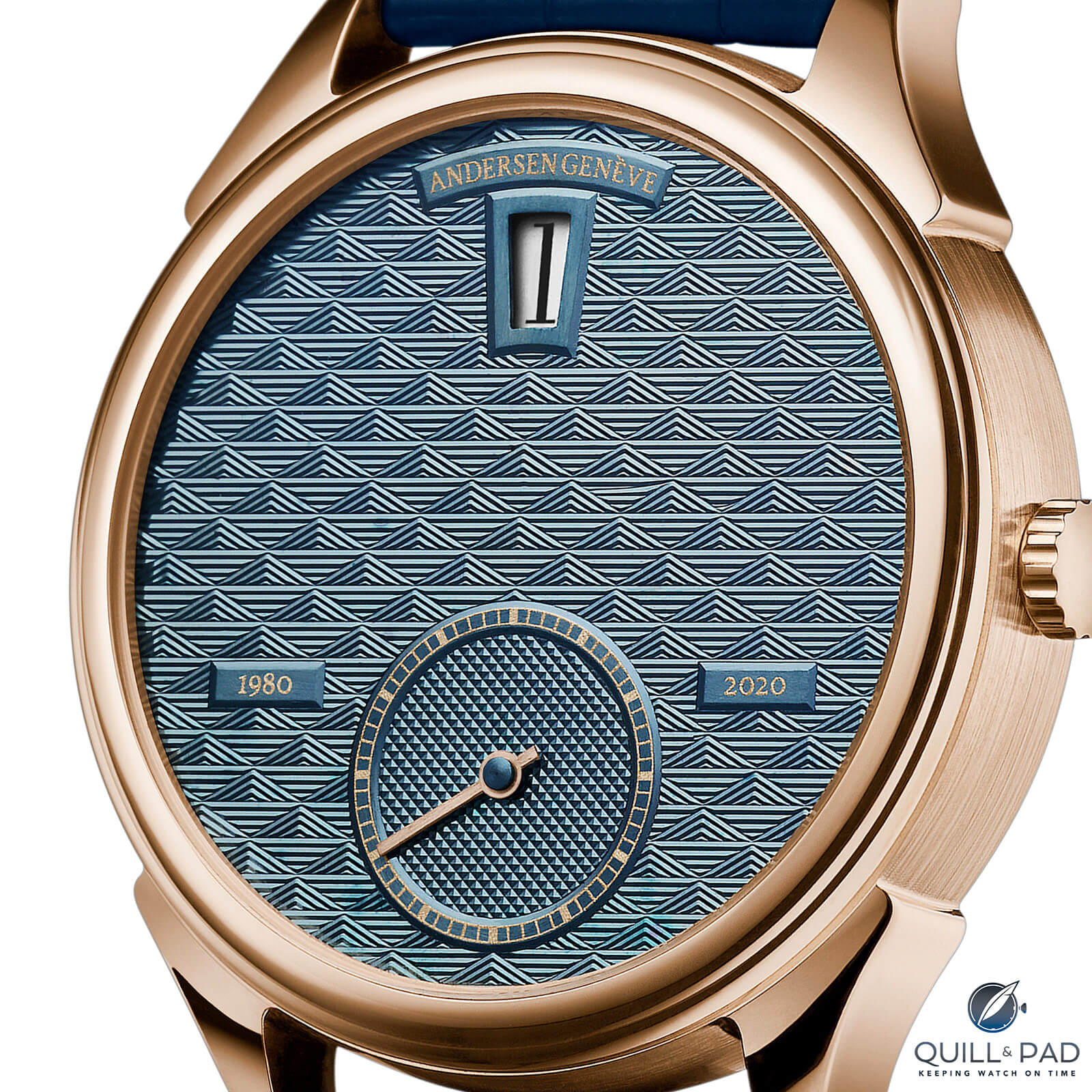
Andersen Genève Jumping Hours 40th Anniversary
The cherry on top of this outstanding dial is perhaps the blue gold platelets to the left and right of the minute subdial proudly emblazoned with “1980” and “2020” to celebrate Andersen Genève’s fortieth anniversary.
The red gold case is classically proportioned, measuring 38 mm in diameter and 9.22 mm in height. And as attractive as the front of the watch is, the back with its 21-karat blue gold ring hand-engraved with “40 years of independent timepiece creation” is simply stunning. It frames the Frédéric Piguet Caliber 11.50 base movement with fine finishing touches and the modified jump hour gear train.
40 + 1: Andersen Genève Jumping Hours in platinum
On the platinum edition of the Andersen Genève Jumping Hours 40th Anniversary, which arrived in June 2021, the hand-guilloche 21-karat blue gold dial really pops, becoming the absolute focal point with a shimmering azure that Andersen Genève has named the “Magical Losanges” dial.
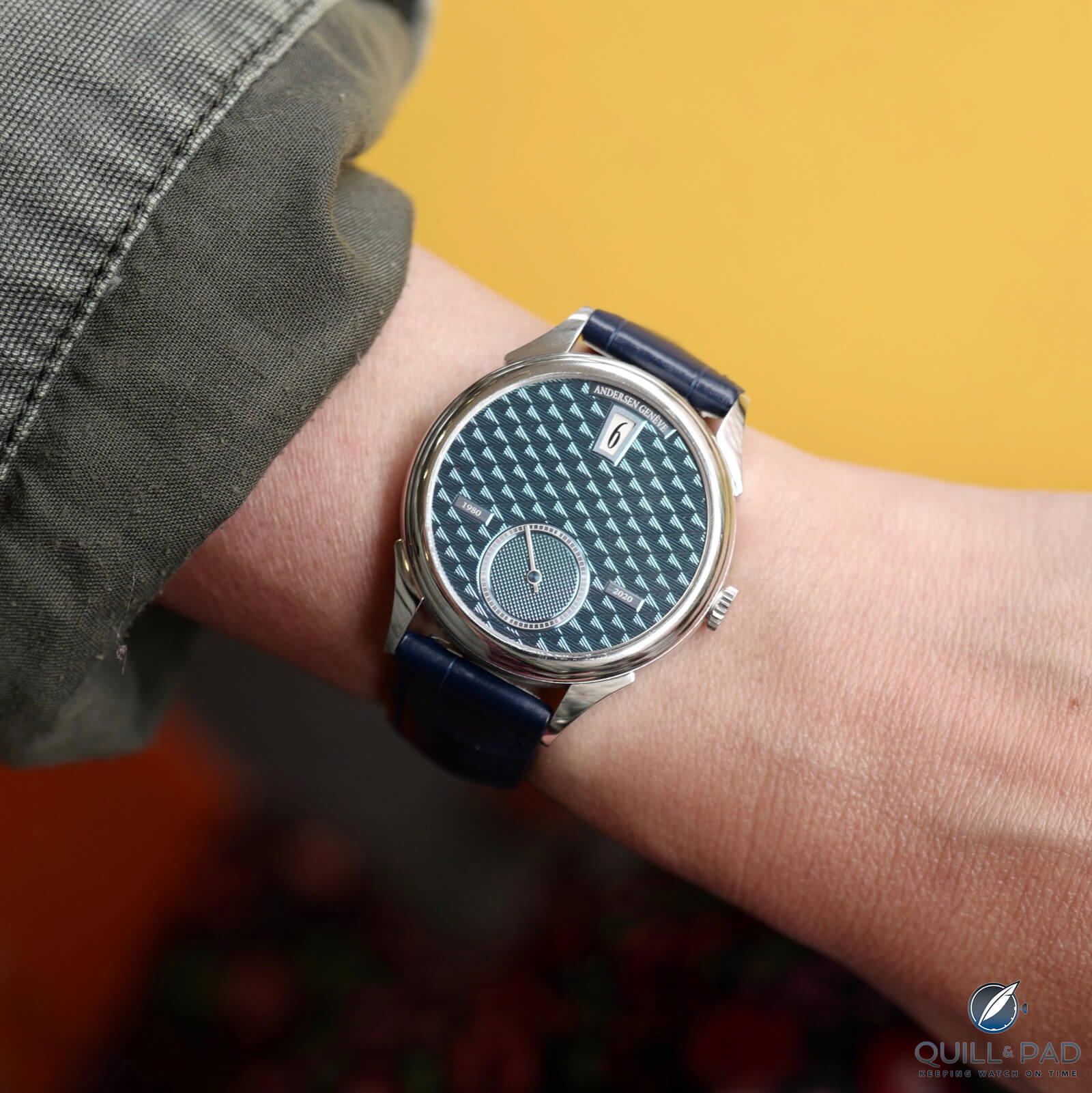
Andersen Genève Jumping Hours 40+1 in platinum (photo courtesy Justin Hast)
To achieve this level of detail requires the artisan to work with three different hand-driven vintage machines. This level of complexity provides the dial with a unique shimmer that shines differently depending on how the light hits it.
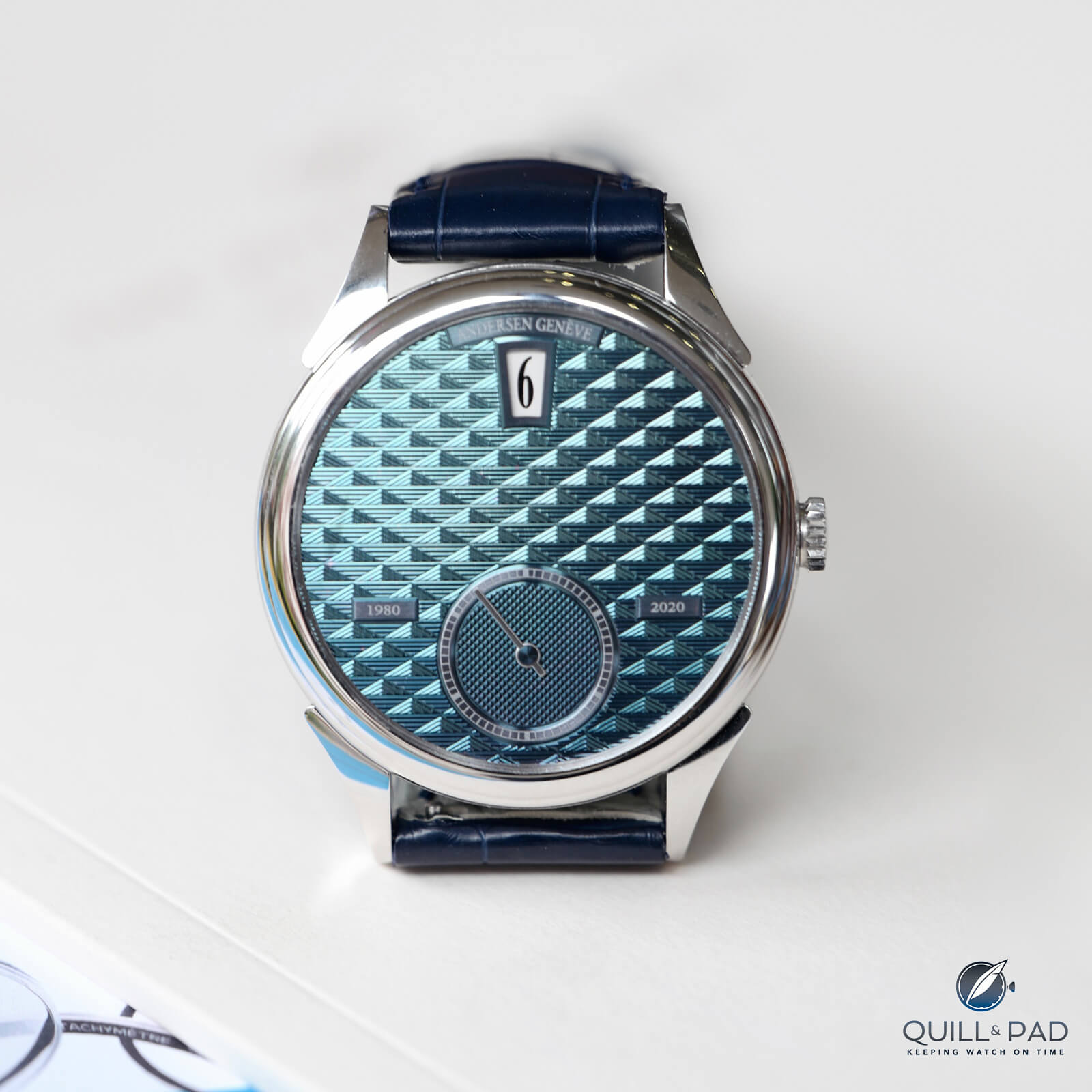
Andersen Genève Jumping Hours 40+1 in platinum (photo courtesy Justin Hast)
A lot of that is chalked up to the combination with blue gold, whose manufacture in itself is an art form. Patented by Ludwig Muller in 1988, blue gold is exclusively available in the watch world through Andersen Genève.
Blue gold is a 21-karat alloy of gold, nickel, and iron that turns blue when the metal is tempered at 450-600°C for about ten minutes. Tempering – also known as heat-treating or bluing – is a process often used in the watch world for steel parts like screws. But using it on gold was novel at the time – and remains an exclusivity.
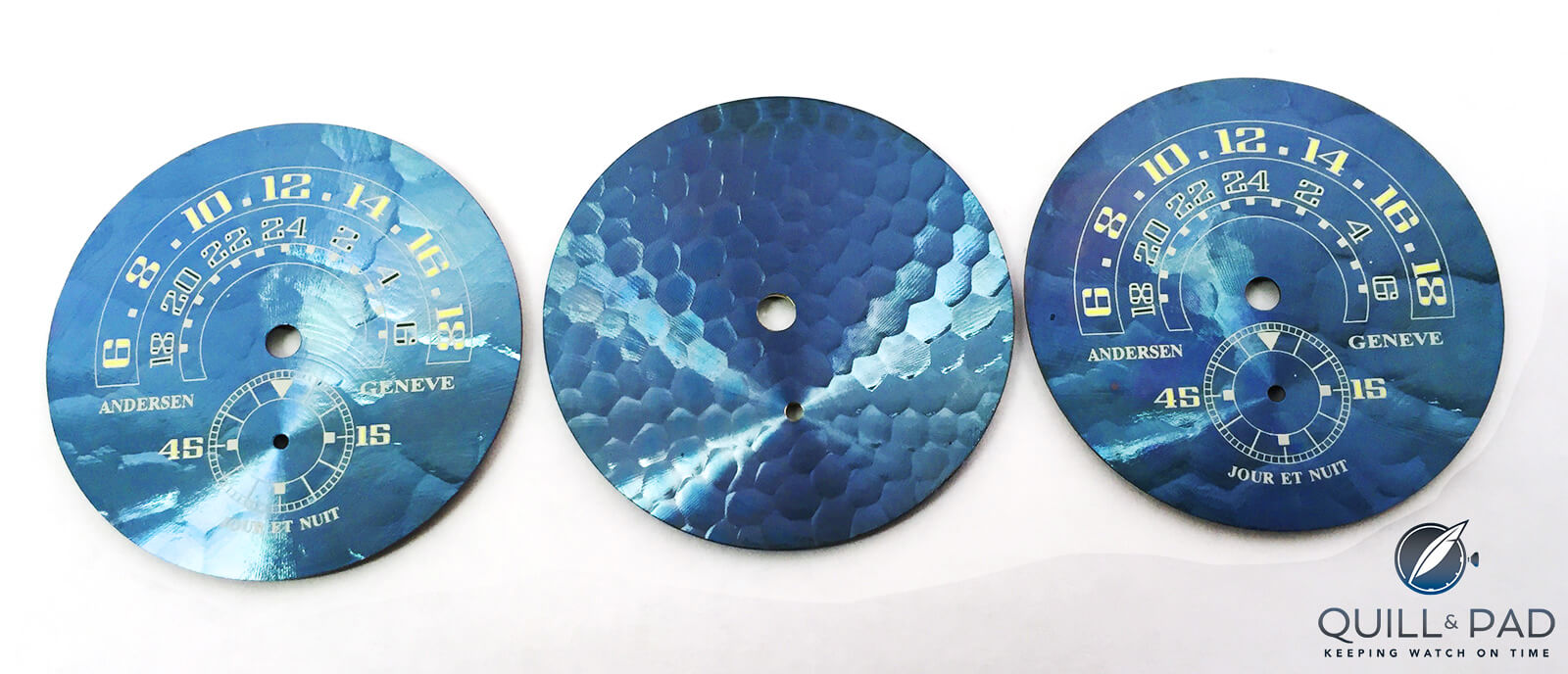
Andersen Genève exclusive blue gold dials
The intensity of the blue increases with the amount of gold in the alloy – so it’s not hard to understand why the 21-karat gold attains this beautiful hue. And no two dials emerge from these processes with quite the same tonality, so in essence each one is unique.
In addition to creating the amazing color, tempering metal this way has the side effect of toughening it by decreasing brittleness and reducing the metal’s internal stresses. Which means that the gold can be worked in gorgeous ways – like the stunning guilloche handcrafted for these dials.
Andersen continues to enjoy the creativity of his chosen profession, now without the added burdens of the day-to-day life of a small business owner. And these new creations in honor of a milestone anniversary are proof positive.
For more information, please visit andersen-geneve.ch.
Quick Facts Andersen Genève/Svend Andersen Grande Jour et Nuit, first edition 2000
Case: 42 x 8 mm, white gold or red gold
Dial: silver-plated, guilloche, applied elements
Movement: manual winding Frédéric Piguet P15 base, modified and finely finished by Svend Andersen, 40-hour power reserve, 3 Hz/21,600 vph frequency
Functions: jumping 24 hours, minutes
Limitation: 20 pieces
Price in 2000: CHF 45,000 / $29,000
Quick Facts Andersen Genève/Svend Andersen Grande Jour et Nuit, second edition
Case: 44 mm, white gold or red gold
Movement: manual winding Frédéric Piguet P15 base, modified and finely finished by Svend Andersen, 40-hour power reserve, 3 Hz/21,600 vph frequency
Functions: jumping 24 hours, minutes
Limitation: 30 pieces in red gold and 20 pieces in white gold
Price: CHF 54,000 excluding VAT
Quick Facts Andersen Genève Jumping Hours 40th Anniversary
Case: 38 x 9.22 mm, red gold or platinum
Dial: 21-karat blue gold, hand-guilloche
Movement: automatic modified Frédéric Piguet Caliber 11.50 with twin spring barrels, power reserve 60 hours, 3 Hz/21,600 vph frequency
Functions: jump hours, minutes
Limitation: 40 pieces in each metal
Price: CHF 37,800 (red gold) / CHF 41,600 (platinum)
You may also enjoy:
Artisans Du Temps: 30th Anniversary AHCI Exhibition At MIH Museum In La Chaux-De-Fonds
Give Me Five! The AHCI Celebrates 30th Anniversary At Baselworld 2015





















































Leave a Reply
Want to join the discussion?Feel free to contribute!